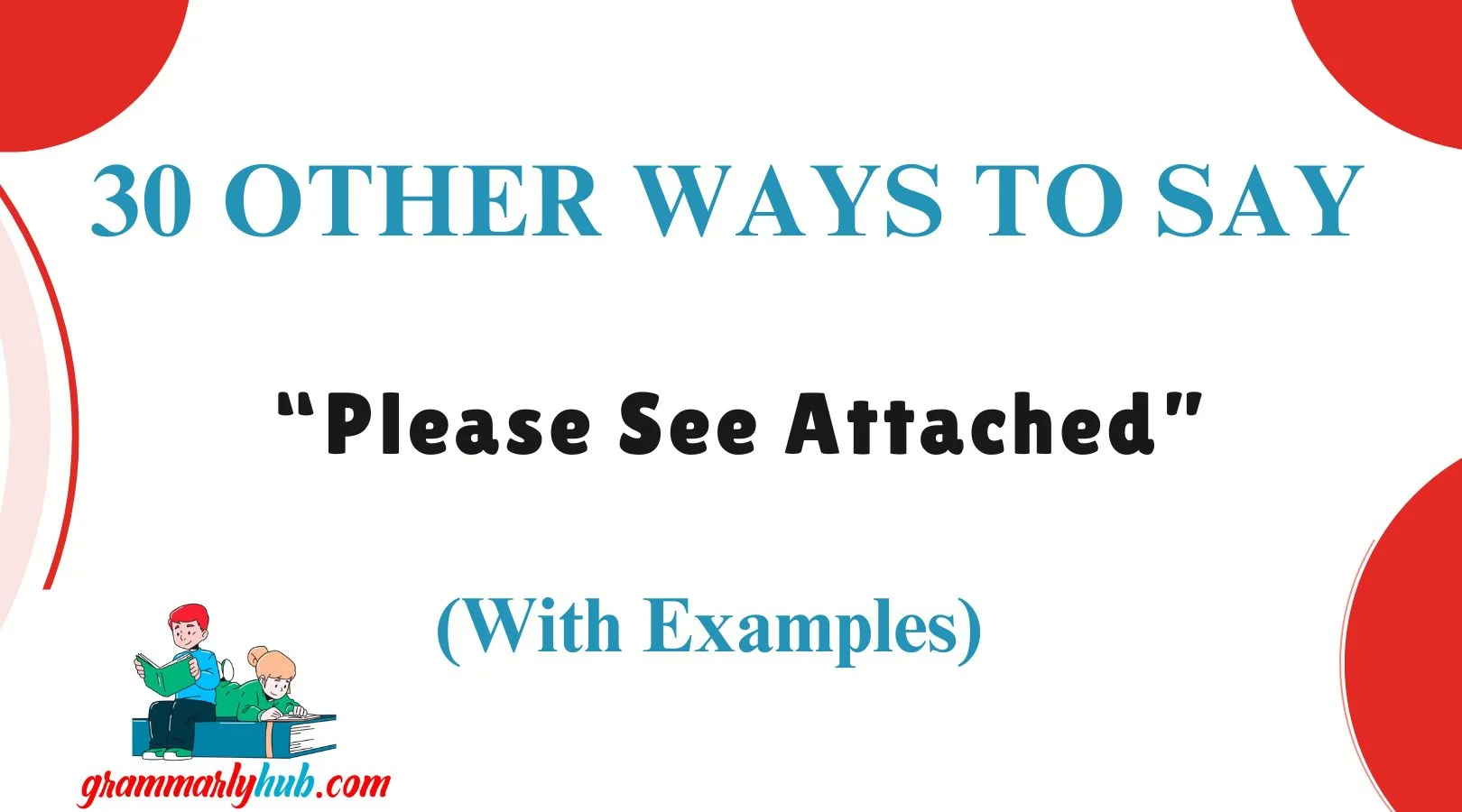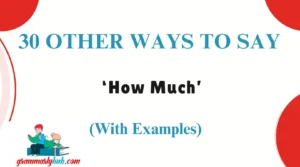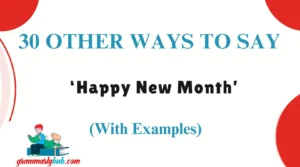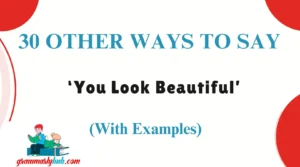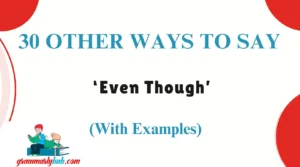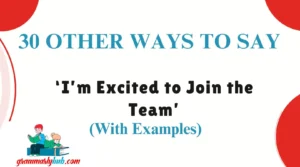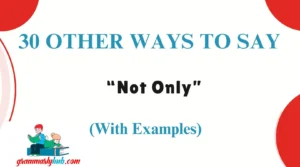When sending professional emails, repeating the same phrases can feel repetitive or impersonal. If you’re looking for other ways to say “please see attached”, you’re not alone. This common phrase, while functional, can benefit from a bit of variety to better suit different tones, audiences, and contexts.
In this article, we’ll explore alternative ways to say “please see attached” that sound professional, warm, and clear. Whether you’re sending resumes, invoices, or documents, using the right phrase enhances clarity and engagement. These email attachment phrases can help you maintain a polished, thoughtful communication style.
Read on to discover multiple other ways to say “please see attached” that feel natural and effective in any situation. Updating your email language isn’t just about words—it’s about making the right impression with every message you send.
What Does “Please See Attached” Mean?
“Please see attached” is a short, formal phrase commonly used in emails to inform the recipient that you’ve included a file or document with the message. It’s professional, clear, and to the point, but can sound a bit impersonal or dated.
When to Use “Please See Attached”
Use it when:
- You’re sharing important documents (contracts, reports, designs, invoices).
- Clarity and professionalism are your top priorities.
- You’re communicating in a formal or corporate environment.
Is It Professional/Polite to Say “Please See Attached”?
Yes, it is. “Please see attached” is professional and polite, but not the only option. If you want to adjust your tone for different recipients or contexts, varying your phrasing can make a big difference.
Pros and Cons of “Please See Attached”
Pros:
- Clear and direct
- Universally understood
- Works well in formal situations
Cons:
- Can sound cold or generic
- Easily overused
- Lacks warmth or customization
Synonyms For Please See Attached
- Attached is…
- I’ve attached…
- Kindly find attached…
- Please find the attached file…
- I’ve included…
- You’ll find…attached
- Here is the file…
- See the attached document…
- The document is attached…
- Enclosed is…
- I’m sending you…
- Attached you’ll find…
- Attached for your reference…
- The file is attached below…
- You’ll find it attached…
- Document included…
- I’ve uploaded…
- You can access the file here…
- See below…
- I’ve shared the file with you…
- Please review the attached…
- The document has been added…
- Uploaded here for your review…
- Available in the attachment…
- Here’s the requested file…
- The requested information is attached…
- Included per your request…
- Shared as requested…
- Included below…
- Refer to the attached file…
1. Attached is…
Definition: A brief and direct way to inform the reader a file is attached.
Explanation: A simple passive structure, best for formal emails.
Example: Attached is the invoice for your review.
Worst Use: In casual emails—it may sound too stiff.
Tone: Professional, concise, neutral.
2. I’ve attached…
Definition: A personal and direct statement about the included file.
Explanation: First-person phrasing adds warmth while staying professional.
Example: I’ve attached the final proposal for your approval.
Worst Use: Rarely inappropriate, but avoided in extremely formal legal writing.
Tone: Friendly, clear, personal.
3. Kindly find attached…
Definition: A slightly formal, polite expression.
Explanation: Sounds respectful, often used in global or cross-cultural settings.
Example: Kindly find attached the signed agreement.
Worst Use: Can feel overly formal in startup or casual environments.
Tone: Polite, respectful, courteous.
4. Please find the attached file…
Definition: Another formal variation of “please see attached.”
Explanation: Clear, courteous, and common in business writing.
Example: Please find the attached file for your review.
Worst Use: In conversational team chats—it feels too stiff.
Tone: Polished, neutral, professional.
5. I’ve included…
Definition: Slightly more casual and conversational.
Explanation: Useful when you’re attaching something helpful or optional.
Example: I’ve included a rough draft for your feedback.
Worst Use: Not ideal for very formal or legal contexts.
Tone: Approachable, helpful, friendly.
6. You’ll find…attached
Definition: Passive phrasing that remains polite.
Explanation: Creates a smooth and gentle flow in your email.
Example: You’ll find the updated slides attached.
Worst Use: May sound too indirect if action is urgent.
Tone: Subtle, professional, calm.
7. Here is the file…
Definition: Very direct and clear.
Explanation: Great for fast communication, especially internally.
Example: Here is the file we discussed yesterday.
Worst Use: Too informal for external client communication.
Tone: Efficient, casual, to the point.
8. See the attached document…
Definition: Classic and clear.
Explanation: Used when referring to specific content.
Example: See the attached document for more details.
Worst Use: Avoid overuse—it can feel robotic.
Tone: Neutral, clarifying, straightforward.
9. The document is attached…
Definition: Descriptive and confident.
Explanation: States that the attachment is ready and available.
Example: The document is attached for your convenience.
Worst Use: When more context or explanation is needed.
Tone: Direct, calm, assured.
10. Enclosed is…
Definition: Slightly traditional phrasing, often used in letters.
Explanation: Good for formal and legal correspondence.
Example: Enclosed is the final version of the agreement.
Worst Use: In casual or internal emails—it feels outdated.
Tone: Formal, traditional, precise.
11. I’m sending you…
Definition: A warm, active way to inform someone you’re including a file.
Explanation: This phrase adds a personal touch by focusing on your action of sharing, not just the file’s existence.
Example: I’m sending you the updated schedule so you can plan accordingly and share feedback if needed.
Worst Use: Avoid in automated or highly formal email templates—it can feel too casual or personal.
Tone: Warm, direct, intentional.
12. Attached you’ll find…
Definition: A polished and gently formal way to guide the recipient toward the file.
Explanation: Combines clarity and courtesy by directing attention to the file without sounding robotic.
Example: Attached you’ll find the project timeline, which outlines all key deadlines and deliverables.
Worst Use: May sound overly formal in quick back-and-forth team chats or casual threads.
Tone: Polite, professional, respectful.
13. Attached for your reference…
Definition: A clear signal that the attachment is optional but useful.
Explanation: This phrase implies that the document isn’t urgent but may provide helpful background or context.
Example: Attached for your reference is last year’s budget summary, which may assist during your planning.
Worst Use: Shouldn’t be used when the attachment is required or urgent—it can imply it’s just for review.
Tone: Informative, supportive, non-intrusive.
14. The file is attached below…
Definition: A straightforward, slightly more visual cue.
Explanation: Especially helpful when sending multiple files or when referring to placement in the message.
Example: The file is attached below in case you need to revisit our earlier conversation or decisions.
Worst Use: Not ideal if you’re attaching a document to a secure external platform instead of directly in email.
Tone: Clear, instructional, neutral.
15. You’ll find it attached…
Definition: A soft and reader-focused alternative.
Explanation: Directs attention in a considerate way, helping your message sound both clear and courteous.
Example: You’ll find it attached with my comments and suggestions to support your revisions more easily.
Worst Use: When writing highly formal letters that require passive, impersonal phrasing.
Tone: Friendly, subtle, thoughtful.
16. Document included…
Definition: A crisp, minimal alternative best suited for quick internal emails.
Explanation: Works well when you’re in a hurry but still want to sound professional.
Example: Document included for your review and any changes you may want to propose before finalization.
Worst Use: In emails where clarity about what is attached is critical—it’s a bit too vague.
Tone: Concise, efficient, businesslike.
17. I’ve uploaded…
Definition: Indicates the file has been placed on a shared drive or platform.
Explanation: Perfect for modern workflows where attachments live on cloud-based tools like Google Drive or SharePoint.
Example: I’ve uploaded the draft presentation to our shared folder for your quick access and feedback.
Worst Use: Don’t use when the file is actually physically attached, as it may confuse the recipient.
Tone: Modern, technical, collaborative.
18. You can access the file here…
Definition: A user-friendly phrase that works well when linking externally hosted documents.
Explanation: Clear and actionable, great for keeping things accessible and smooth for the recipient.
Example: You can access the file here for a full breakdown of our team’s analysis and forecasts.
Worst Use: Shouldn’t be used if there’s no link or if attachments are sent directly via email.
Tone: Helpful, digital-first, respectful.
19. See below…
Definition: A quick signal to look further down in the email body or at the attachment.
Explanation: Best used when referencing both written content and attached documents in the same message.
Example: See below for the revised scope of work and attached document containing the full breakdown.
Worst Use: Too vague on its own—should be paired with a specific mention of the file name or purpose.
Tone: Casual, directional, brief.
20. I’ve shared the file with you…
Definition: Communicates both action and intention, particularly in collaborative settings.
Explanation: Emphasizes the act of sharing, which can feel more cooperative and personal.
Example: I’ve shared the file with you via Dropbox so you can edit directly before tomorrow’s meeting.
Worst Use: Avoid if you’re not using a file-sharing platform, as it implies collaborative editing access.
Tone: Inclusive, transparent, cooperative.
21. Please review the attached…
Definition: Adds a layer of action beyond simply notifying about the file.
Explanation: Encourages the recipient to engage with the attachment, not just acknowledge it.
Example: Please review the attached document and let me know if you’d like to make any adjustments.
Worst Use: Avoid when no response or review is needed, as it might confuse the recipient.
Tone: Action-oriented, clear, engaging.
22. The document has been added…
Definition: Passive yet professional—emphasizes inclusion more than who did it.
Explanation: Useful in formal workflows or automated systems, especially when sender identity isn’t central.
Example: The document has been added for your records and future reference.
Worst Use: Too impersonal for 1:1 communication with clients or colleagues.
Tone: Neutral, process-driven, informational.
23. Uploaded here for your review…
Definition: Guides the recipient toward reviewing a document uploaded to a shared space.
Explanation: A bit more modern and task-focused than older formats.
Example: Uploaded here for your review: the draft marketing calendar for Q4 planning.
Worst Use: In emails where files are attached directly—it may cause confusion.
Tone: Professional, instructional, collaborative.
24. Available in the attachment…
Definition: Phrasing that combines clarity with a touch of formality.
Explanation: Makes the file sound like a resource rather than a task.
Example: The updated pricing model is available in the attachment for your convenience.
Worst Use: In casual updates—it may come across as too stiff or impersonal.
Tone: Balanced, respectful, resourceful.
25. Here’s the requested file…
Definition: Personal and courteous; acknowledges a previous request.
Explanation: Reassures the recipient that you’re following through on a specific ask.
Example: Here’s the requested file containing all the recent performance metrics and reports.
Worst Use: If the file wasn’t actually requested—it could sound presumptive or confusing.
Tone: Courteous, responsive, reliable.
26. The requested information is attached…
Definition: Very formal and precise way to follow up on a prior request.
Explanation: Great for customer support or legal contexts where clear documentation matters.
Example: The requested information is attached for your compliance review and internal use.
Worst Use: Can feel cold in friendly or informal interactions.
Tone: Formal, precise, professional.
27. Included per your request…
Definition: A respectful and formal acknowledgment of the recipient’s needs.
Explanation: Reinforces that you’re being attentive and detail-oriented.
Example: Included per your request are the original design files and alternate color mockups.
Worst Use: Too formal for internal conversations or casual sharing.
Tone: Deferential, respectful, service-minded.
28. Shared as requested…
Definition: Concise confirmation that the attachment is in response to a specific ask.
Explanation: Great for quick replies to clients, customers, or team leads.
Example: Shared as requested: the latest update on project timelines and deliverables.
Worst Use: Shouldn’t be used if no request was made—it may sound disingenuous.
Tone: Direct, respectful, acknowledging.
29. Included below…
Definition: Simple and directional; ideal when referencing multiple documents or sections.
Explanation: Helps orient the reader to where the attachment or relevant section is located.
Example: Included below is the report you asked for, along with supporting notes from the team.
Worst Use: May be unclear if nothing is actually placed below—double-check your layout.
Tone: Straightforward, navigational, neutral.
30. Refer to the attached file…
Definition: Formal and directive, suitable for instructions or documentation.
Explanation: Often used when the attachment contains technical specs, instructions, or legal terms.
Example: Refer to the attached file for installation procedures and warranty information.
Worst Use: Not great for casual sharing or friendly communication—it sounds too stiff.
Tone: Authoritative, formal, instructional.
FAQs:
1. What can I say instead of “please find attached”?
You can say “I’ve attached [document name] for your reference” or “Attached is the [file name] you requested.”
These phrases sound courteous and are commonly used in professional emails.
2. How do I politely say “please see attached”?
Try using “Kindly refer to the attached document” or “You’ll find the file attached below.”
They sound respectful and maintain a professional tone without being overly formal.
3. What is another way to say see attached?
You might say “Enclosed is the document you asked for” or “Here is the file for your review.”
These alternatives are direct yet polite for work-related communications.
4. What is another way to say PFA?
Instead of “PFA,” use “Attached is…” or “I’ve included the file with this email.”
These expressions are clearer and more professional in business correspondence.
5. How do I say attachment in an email?
You can say “Please see the attached file” or “The requested document is attached.”
It’s helpful to name the file specifically to avoid confusion and improve clarity.
Conclusion
Choosing the right words in professional communication matters—and that includes how you reference attachments. By using other ways to say “please see attached”, you can tailor your message to better match your tone, audience, and intent. Whether you’re aiming for formal, friendly, or concise, these email attachment phrases offer flexibility and clarity. Refreshing your language shows attention to detail and enhances how your message is received. As you continue to write emails, consider using these other ways to say “please see attached” to keep your communication polished and engaging. Small changes can make a big impact.

Welcome to GrammarlyHub, your trusted resource for writing clarity, grammar insights, and language tools. Founded by Mia Rose, a passionate writer and language enthusiast, GrammarlyHub is dedicated to helping students, professionals, and creatives write with confidence and precision.
